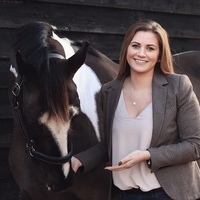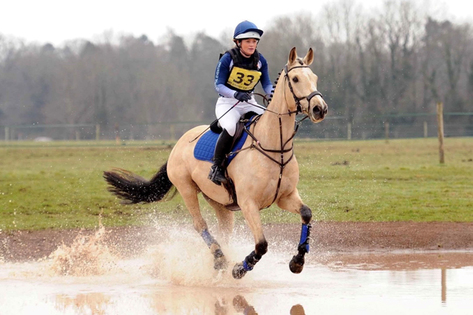
Are You & Your Horse Ready For Bitting Advice? The Steps You Need To Consider First
Equestrian Advice & Guides All Disciplines
Build your business profile for FREE and expose your services to thousands of potential clients!
Create my profile now!
As an event rider, it's hard to know how best to prepare for the Eventing season. Rachael tells us how she prepares herself and her horse, Bailey, and runs through her training plan for each discipline, including top tips for increasing fitness levels and getting organised before the event.
Fitness Training
There are many areas I look at when preparing for the Eventing season. The key thing for all eventers is ensuring that the horse is fit and ready for the event, and is fully trained and working well in all 3 disciplines.
So, the time has come to start ensuring Bailey is fit enough for any course we go on; some are flat with more speed areas, and some have a lot of hills. So his fitness for the next event season is very important.
 Throughout winter our training has not stopped (no rest for the wicked!) as we were mainly focusing on the dreaded, boring schooling and flatwork to improve our Dressage score, getting him nice and supple and more established than last season. We all know, to have a decent jump you need the basics and the groundwork backing you up. We also attended several dressage competitions to help battle my fear of the Dressage test, and I feel I have improved rapidly already. Although this work may seem boring if you’re not a Dressage rider and love to jump, it’s a key factor and worth putting in the effort. I also used this as an opportunity to become more comfortable riding in my Dressage saddle, as well as forever improving my position.
Throughout winter our training has not stopped (no rest for the wicked!) as we were mainly focusing on the dreaded, boring schooling and flatwork to improve our Dressage score, getting him nice and supple and more established than last season. We all know, to have a decent jump you need the basics and the groundwork backing you up. We also attended several dressage competitions to help battle my fear of the Dressage test, and I feel I have improved rapidly already. Although this work may seem boring if you’re not a Dressage rider and love to jump, it’s a key factor and worth putting in the effort. I also used this as an opportunity to become more comfortable riding in my Dressage saddle, as well as forever improving my position.
Now let’s talk about something a bit more interesting, that without a doubt we will all find more exciting than the Dressage phase... the jumping! Some people aren’t too keen on the Showjumping phase either, and for them it’s all about Cross Country, but this is my favourite bit.
I start introducing jumping into our training at around 9 weeks before the season starts. So this year we already had a jump in January, nothing stressful, just something nice and simple to bring him back into it. I could tell he was excited to be jumping again, which was a great feeling to know he loves it too. Of course I start off slow and focus on increasing the height and complexity over time. So we focus on our technique lines, starting off very simple, keeping the jumps on the long and short lines, then gradually getting more and more technical with different lines, angles and strides.
The good thing about the school is that it’s easy to keep changing the jumps to make tighter turns and more angled jumps, as well as making more technically challenging lines in a safe environment. This gets you ready to start introducing the Cross Country. When I start jumping, I initially do it once every other week, and then around 3-4 weeks before the season starts I will increase this to once a week, provided I’m not going Cross Country during that week.

I start to introduce Cross Country at around 6 weeks before, as I don’t get as much time to go out and fit this training in, so I begin as early as possible when venues start reopening their courses after the winter. To start off with I keep everything slow and small to get Bailey use to it all again, showing him the jumps by trotting into them so he isn’t jumping through his adrenaline, which helps build his confidence with the jumps. The next time we go I’ll ask more from him, increasing the height, but not so much the speed. By the last visit before our event, I’ll warm up over a few jumps and then put together a nice course to run through as if we were at the event, but by this time he should have honed his skill as well as his fitness.

I start the fitness side of training at around 5 weeks before the event. I start increasing the fast work to ensure he’s in the best health, not dehydrated and well balanced. The main fitness training I do is interval training, alternating between short and long, fast and slow, as this is a very effective way of getting them fit for short format, although it will vary from horse to horse. He’s had a few big canters and gallops when we’ve hack out throughout the year, so this won’t be too much of a shock to his system. With that in mind, I will then gradually increase the speed and length, fluctuating the speed of the gallop when we do a longer stretch.
This is an example of the last couple of fitness sessions we would do before the event;
1. Gallop session = 3 gallops for 2 mins with a 1 min trot in between
2. Slow session = 3 steady canters for 2 mins with a 1 min trot in between
3. Gallop session = 4 gallops for 2 mins with a 1 min trot in between
4. Slow session = 3 steady canters for 3 mins with a 1 min trot in between (with a hill)
 Some golden rules for increasing fitness:
Some golden rules for increasing fitness:
Pre-Event Checklist
 Preparing for the season also encompasses lots of other areas that might easily be overlooked. I also need to ensure that I, as the Rider, am ready, and that all of our gear is also fit for purpose and ready to go.
Preparing for the season also encompasses lots of other areas that might easily be overlooked. I also need to ensure that I, as the Rider, am ready, and that all of our gear is also fit for purpose and ready to go.
The last thing you’d want is to run out of breath and turn blue in the face half way round the course as you’re super unfit! Or realise the day before an event that you’ve misplaced an item, or that something doesn’t work, or even have something break on the day!
So here’s my checklist to ensure we’re prepared for the season;
 Before I go to the event, if the venue is open to the public for Cross country schooling, I like to get a quick last minute session in, as I find this really helps ease my nerves and gets Bailey use to the style of fences the venue holds. It also gives me an idea of the venue, especially if I’ve not been there before, plus it’s always nice to have done the drive beforehand so you know exactly where you’re going and where to find the entrance.
Before I go to the event, if the venue is open to the public for Cross country schooling, I like to get a quick last minute session in, as I find this really helps ease my nerves and gets Bailey use to the style of fences the venue holds. It also gives me an idea of the venue, especially if I’ve not been there before, plus it’s always nice to have done the drive beforehand so you know exactly where you’re going and where to find the entrance.
A few days before the event I also give all my tack and boots a nice strip clean, and Bailey gets a hot cloth wipe along with a general mane and tail tidy. This is also when I get all of my stuff together in one place, ready to load up.
 On the day of the event I get up extra early to plait up and give him a deep groom, as he’s guaranteed to lay in poo and have stains all over him! I make sure I leave earlier than I actually need to so that I don’t feel rushed when I get to the venue, and it gives me plenty of time to settle in.
On the day of the event I get up extra early to plait up and give him a deep groom, as he’s guaranteed to lay in poo and have stains all over him! I make sure I leave earlier than I actually need to so that I don’t feel rushed when I get to the venue, and it gives me plenty of time to settle in.
For tips on improving your Dressage skills, check out some of my other articles;

